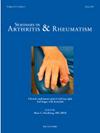Developing efficient predictive models for the diagnosis of VEXAS syndrome
IF 4.4
2区 医学
Q1 RHEUMATOLOGY
引用次数: 0
Abstract
Objectives
To identify clinical and laboratory features associated with the presence of UBA1 mutation and develop predictive models to guide efficient diagnosis of VEXAS syndrome.
Methods
All patients who underwent UBA1 mutation testing were identified. Using a comprehensive list of VEXAS syndrome features, the presence or absence of each feature in each patient was determined for two timepoints: time of first VEXAS symptom onset and the time of UBA1 mutation testing. For each timepoint, the presence of each disease feature was compared between UBA1 positive and negative patients. The least absolute shrinkage and selection operator (LASSO) method was used to develop multi-feature models to predict the presence of pathogenic UBA1 mutations.
Results
Overall, 144 patients who underwent UBA1 mutation testing were included. Features including skin rash, chondritis, and monocytopenia were significantly associated with the presence of a UBA1 mutation at both timepoints. Macrocytosis, uveitis, and pulmonary disease had significant association at time of testing. 12-feature and 5-feature LASSO models at symptom onset demonstrated good discriminatory capacity with areas under receiver operating curves (AUCs) of 0.86 and 0.81, respectively. 16-variable and 5-feature models at time of testing had good-to-excellent performance with AUCs of 0.92 and 0.84, respectively. A single feature model utilizing absolute monocyte count also had fair discriminatory capacity with AUC of 0.78 at both timepoints.
Conclusions
Multi-feature models that efficiently separate VEXAS cases from controls were successfully developed. These models have the potential to address existing diagnostic challenges including a lack of consensus regarding key features of VEXAS syndrome.
建立诊断VEXAS综合征的有效预测模型
目的探讨与UBA1突变存在相关的临床和实验室特征,建立预测模型,指导对VEXAS综合征的有效诊断。方法对所有患者进行UBA1突变检测。使用综合的VEXAS综合征特征列表,在两个时间点确定每个患者每个特征的存在或不存在:首次出现VEXAS症状的时间和进行UBA1突变检测的时间。在每个时间点,比较UBA1阳性和阴性患者各疾病特征的存在情况。使用最小绝对收缩和选择算子(LASSO)方法建立多特征模型来预测致病性UBA1突变的存在。结果共纳入144例UBA1突变检测患者。在这两个时间点,皮疹、软骨炎和单核细胞减少症等特征与UBA1突变的存在显著相关。巨噬细胞增多症、葡萄膜炎和肺部疾病在检测时有显著的相关性。12特征和5特征LASSO模型在症状开始时表现出良好的区分能力,受试者工作曲线下面积(auc)分别为0.86和0.81。在测试时,16变量和5特征模型的auc分别为0.92和0.84,具有良好到优异的性能。使用绝对单核细胞计数的单一特征模型也具有公平的区分能力,在两个时间点的AUC均为0.78。结论成功建立了多特征模型,可以有效地将VEXAS病例与对照组区分开来。这些模型有可能解决现有的诊断挑战,包括对VEXAS综合征的主要特征缺乏共识。
本文章由计算机程序翻译,如有差异,请以英文原文为准。
求助全文
约1分钟内获得全文
求助全文
来源期刊
CiteScore
9.20
自引率
4.00%
发文量
176
审稿时长
46 days
期刊介绍:
Seminars in Arthritis and Rheumatism provides access to the highest-quality clinical, therapeutic and translational research about arthritis, rheumatology and musculoskeletal disorders that affect the joints and connective tissue. Each bimonthly issue includes articles giving you the latest diagnostic criteria, consensus statements, systematic reviews and meta-analyses as well as clinical and translational research studies. Read this journal for the latest groundbreaking research and to gain insights from scientists and clinicians on the management and treatment of musculoskeletal and autoimmune rheumatologic diseases. The journal is of interest to rheumatologists, orthopedic surgeons, internal medicine physicians, immunologists and specialists in bone and mineral metabolism.

 求助内容:
求助内容: 应助结果提醒方式:
应助结果提醒方式:


